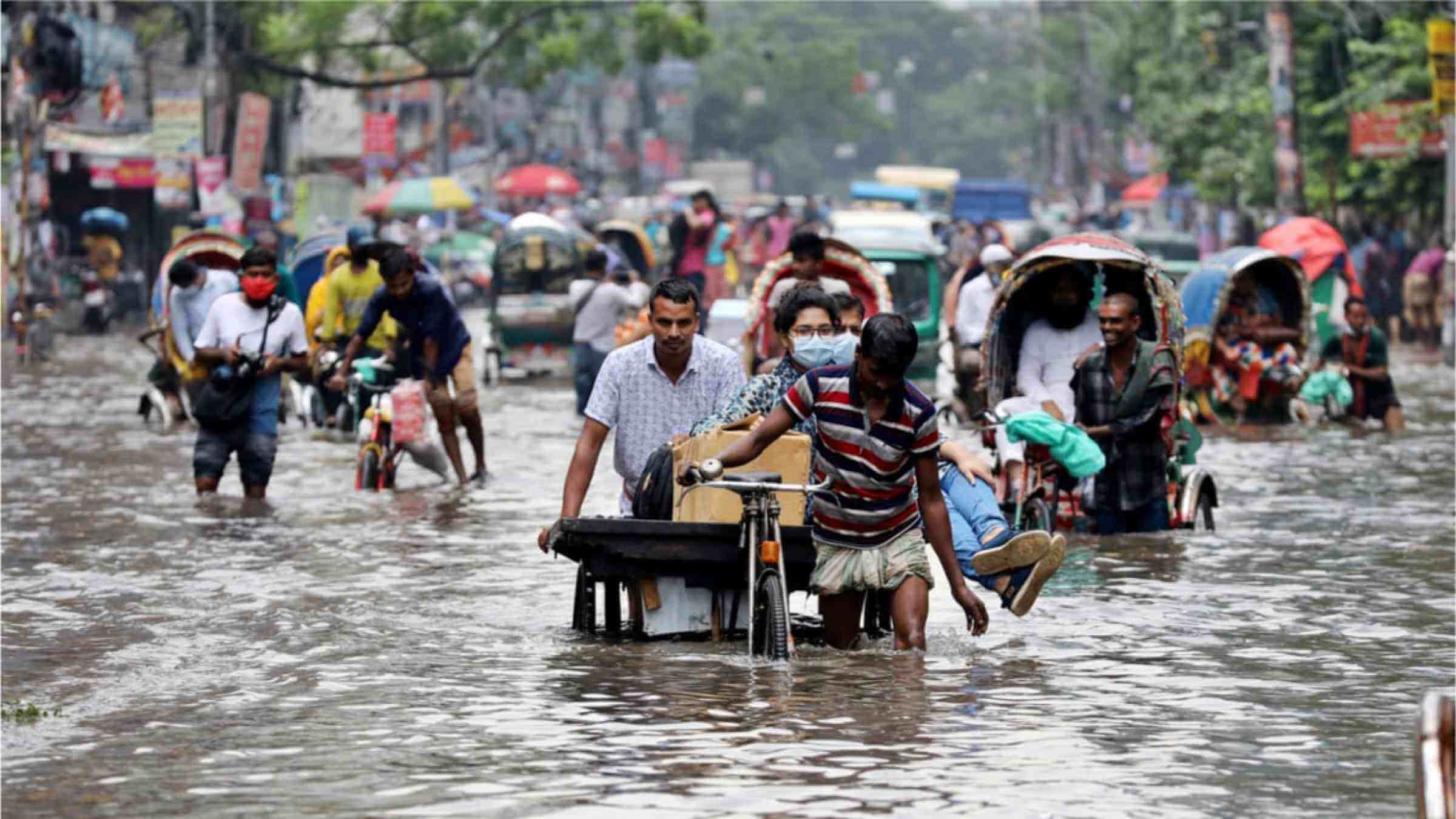Floods are among the most common and destructive natural disasters worldwide, causing widespread damage to property, infrastructure, and human lives. A flood occurs when water overflows onto normally dry land due to heavy rainfall, river overflow, dam breaches, or the rapid melting of snow and ice. While floods can be seasonal or sudden, their consequences can be long-lasting, impacting economies, ecosystems, and communities. In this article, we will take an in-depth look at what causes floods, their types, the devastating effects they can have, and the strategies used to mitigate their impact.
What Causes Floods?
Flooding can be caused by various natural and human-induced factors. Some of the key causes include:
1. Heavy Rainfall
Excessive rainfall is one of the primary causes of flooding, especially in areas with poor drainage systems or low-lying land. When rainwater cannot be absorbed by the ground or channelled away effectively, it leads to an accumulation of water, causing floods. Monsoons, tropical storms, and prolonged rainfall are common causes of flood events in various regions around the world.
2. River Overflow
Rivers and streams can overflow when they receive more water than they can hold, either due to continuous rainfall or the rapid melting of snow. This can lead to the inundation of nearby areas, causing severe riverine floods. Floodplains, which are low-lying areas adjacent to rivers, are particularly prone to this type of flooding.
3. Storm Surges and Coastal Flooding
In coastal areas, storm surges caused by hurricanes, cyclones, or tsunamis can push ocean water inland, resulting in severe coastal flooding. This type of flooding is especially destructive due to the high velocity and force of the incoming water, which can demolish structures, erode coastlines, and submerge large areas.
4. Urbanization and Poor Drainage Systems
Rapid urbanization can contribute to flooding, as cities with a high concentration of impermeable surfaces (like concrete and asphalt) have reduced natural absorption of rainwater. Poorly planned urban areas often lack adequate drainage systems, which can exacerbate flooding during heavy rains. Flash floods are particularly common in urban areas due to the sudden accumulation of water with no effective means to disperse it.
5. Dam Failures and Infrastructure Breakdowns
The failure of dams or levees can cause catastrophic floods. These structures are designed to control water flow, but when they fail—due to structural weaknesses, mismanagement, or natural events—they can release large volumes of water, flooding downstream areas.
6. Climate Change
Climate change is increasingly being recognized as a significant factor contributing to the frequency and severity of floods. Rising global temperatures are leading to more intense rainfall patterns, accelerated snowmelt, and rising sea levels, all of which contribute to increased flooding risks across the globe.
 Types of Floods
Types of Floods
Floods can occur in different forms depending on the geographic region and the contributing factors. Some of the most common types of floods include:
1. Riverine Flooding
This type of flood occurs when rivers or streams overflow their banks due to excessive rainfall or snowmelt. Riverine flooding can last for days or weeks, and the severity often depends on the volume of water and the size of the river.
2. Flash Flooding
Flash floods are sudden, intense floods that occur within a short period, usually as a result of heavy rainfall or dam breaks. They are characterized by rapid water accumulation and fast-moving water, which can sweep away people, vehicles, and buildings in its path.
3. Coastal Flooding
Coastal areas are particularly susceptible to flooding caused by storm surges, high tides, or tsunamis. Coastal floods are often exacerbated by rising sea levels, which push more water inland during storm events.
4. Urban Flooding
Urban areas with inadequate drainage systems or poor planning can experience urban flooding during periods of heavy rainfall. This type of flooding is common in densely populated cities, where there is little natural land to absorb excess water.
5. Pluvial Flooding
Pluvial floods, also known as surface water floods, occur when heavy rainfall creates a build-up of water in an area that cannot drain properly. This type of flood is common in areas where the soil is already saturated or in regions with poor infrastructure.
The Devastating Effects of Flooding
Floods have far-reaching consequences that extend beyond the immediate inundation of land. The impacts can be both economic and environmental, as well as social. Here are some of the most common effects of flooding:
1. Damage to Infrastructure and Property
Flooding can cause extensive damage to homes, roads, bridges, and other infrastructure. The force of floodwaters can erode foundations, collapse buildings, and wash away vehicles. In urban areas, underground infrastructure such as subways, sewers, and electrical systems can be severely affected, leading to additional hazards like power outages or contamination.
2. Displacement of Communities
Floods often force people to evacuate their homes, leading to the displacement of entire communities. In severe cases, people may lose their homes and belongings permanently, leading to long-term homelessness and requiring significant aid from governments and international organizations.
3. Loss of Life
Flooding can be fatal, particularly during flash floods where water levels rise quickly and unexpectedly. In addition to drowning, floods can cause secondary hazards, such as mudslides or debris flows, which can also claim lives.
4. Economic Impact
The economic costs of floods can be staggering. Beyond the immediate cost of repairs and rebuilding, businesses may suffer losses due to interrupted operations, damaged inventory, and reduced consumer demand in the aftermath of a flood. Agricultural sectors are also heavily impacted by floods, as crops, livestock, and farmland can be destroyed, leading to food shortages and rising prices.
5. Environmental Consequences
Floods can also have long-lasting environmental effects. They can wash away soil, causing erosion and damaging natural ecosystems. In some cases, floods can lead to contamination of water sources, especially when industrial waste or chemicals are spread by floodwaters. Additionally, floods can lead to the loss of wildlife habitats and disrupt the balance of local ecosystems.
Flood Mitigation and Prevention Measures
While floods cannot always be predicted or prevented, various measures can be taken to mitigate their impact and protect communities. Some of the most effective flood prevention strategies include:
1. Improved Drainage Systems
Urban areas should invest in better drainage systems to prevent water from accumulating during periods of heavy rain. This includes building more efficient stormwater drains, installing permeable surfaces, and creating green spaces that allow for water absorption.
2. Flood Barriers and Levees
Flood barriers and levees are man-made structures designed to contain or divert floodwaters away from critical areas. These barriers can help protect cities, farmland, and industrial areas from being inundated during severe floods.
3. Early Warning Systems
Having effective early warning systems in place can save lives and reduce property damage by giving people enough time to evacuate or take precautions before floodwaters arrive. Governments should invest in accurate weather forecasting and flood alert systems to better prepare their citizens.
4. Sustainable Urban Planning
Cities must plan for flood risks by ensuring that development projects take into account natural water flow patterns and avoid building in flood-prone areas. Creating buffer zones, such as wetlands and green belts, can help absorb excess water during flood events.
5. Reforestation and Soil Conservation
Reforestation and maintaining healthy natural vegetation can help prevent soil erosion and promote water absorption, reducing the severity of floods in rural and semi-urban areas. Tree roots and plants naturally hold the soil together, helping to slow down the flow of water.
6. Public Awareness and Education
Educating the public on flood safety measures, such as how to evacuate, what supplies to keep handy, and how to protect personal belongings, can go a long way in reducing the human impact of floods. Public awareness campaigns are crucial for ensuring that communities understand the risks and are prepared for future flooding events.
Conclusion
Floods are a natural disaster that pose significant challenges to communities, economies, and ecosystems around the world. While we cannot always prevent flooding, understanding its causes, effects, and the measures that can be taken to mitigate its impact is essential in reducing the devastation it can cause. From enhancing infrastructure and urban planning to educating the public and employing sustainable environmental practices, flood mitigation efforts are critical for safeguarding both lives and property.











 Types of Floods
Types of Floods






